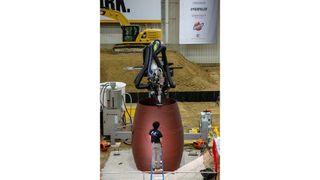Inside a Martian Habitat Factory in New York City
Inside the strange world of 3D printing Martian homes.
NEW YORK -- What are humans going to live in once they're on Mars? One company thinks it has the answer.
Earlier this fall, Space.com visited the main offices of AI SpaceFactory, an architecture and technology design agency that specializes in designing and 3D printing Martian habitats. The company recently competed in and won NASA's 3D-printed habitat challenge with a design called Marsha.
AI SpaceFactory founder and CEO David Malott took Space.com around this space factory here to see what it really takes to build a Martian habitat.
Related: How 3D Printers Could Reinvent NASA Space Food

"The whole reason to do that is, it's too expensive to ship materials to Mars," Malott said to Space.com. "We want a place for the astronauts to stay in," he added. When we are ready to send humans to live on the surface of Mars, they will need somewhere to live. But construction equipment and materials are large and heavy, and it would be both difficult and extremely expensive to send them to another planet.
Buildings on Mars have "to be made robotically in advance of the astronauts arriving using materials made from Mars," Malott added.

The material that the company uses for its Martian printing are, in fact, "made from Mars," in a way. "It's a biopolymer binder with basalt," Malott said. "Basalt is the rock that you find all over Mars." So, while all of the ingredients in the company's printing mixture come from our home planet, they are materials that can also be found on Mars.
Get the Space.com Newsletter
Breaking space news, the latest updates on rocket launches, skywatching events and more!
"The good thing with local Martian materials is they're also local on Earth," he said. The pieces of Marsha scattered around the facility that we picked up and held even felt alien, extremely sturdy, intricately layered and woven, kind of slippery — and overall unique.
Strong, recyclable and Martian
Now, it turns out that printing a habitat with this material is very sensitive to temperature, so the team at AI SpaceFactory monitors the process very closely. "I compare this to cooking eggs," Malott said. "It's all about timing and temperature, and that's why we are forcing ourselves to print Tera, and were printing Tera completely outdoors," he added about Tera, the new Earth habitat the company is working on.
But the careful "cooking" is worth it: The material is not only extremely strong (a major part of how Marsha won the NASA competition) but also "100% recyclable," Malott said. To validate its recyclability, the team even ground up material from Marsha to use to print Tera.

Besides being strong and recyclable, this Martian printing material is also more resource efficient than cement and concrete, which are used in a majority of building projects on Earth. Unlike cement and concrete (which also aren't recyclable), the material's production doesn't require the use of water (not to mention tons of it) or large amounts of energy.
Malott also described some ways in which this Martian 3D printing technology could be applied here on Earth. "One of the challenges on Earth is building in places, say, like the Bahamas, right, which recently got obliterated by a hurricane," he said. "If you need to go somewhere fairly remote where the infrastructure's just been destroyed, and you have to produce a lot of housing, how do you do that?"
"The whole wonder of what we're doing is that, by thinking about the challenge of how to build in an extreme and remote environment on Mars, we're actually solving a fundamental challenge about building on Earth, which is building in a more sustainable way," Malott said.
- 3D Printing: 10 Ways It Could Transform Space Travel
- NASA Announces $100,000 Winners of Virtual 3D-Printed Mars Habitats
- The First Mars Colony Could Be 3D Printed from Red Planet Dust
Follow Chelsea Gohd on Twitter @chelsea_gohd. Follow us on Twitter @Spacedotcom and on Facebook.
Join our Space Forums to keep talking space on the latest missions, night sky and more! And if you have a news tip, correction or comment, let us know at: community@space.com.

Chelsea “Foxanne” Gohd joined Space.com in 2018 and is now a Senior Writer, writing about everything from climate change to planetary science and human spaceflight in both articles and on-camera in videos. With a degree in Public Health and biological sciences, Chelsea has written and worked for institutions including the American Museum of Natural History, Scientific American, Discover Magazine Blog, Astronomy Magazine and Live Science. When not writing, editing or filming something space-y, Chelsea "Foxanne" Gohd is writing music and performing as Foxanne, even launching a song to space in 2021 with Inspiration4. You can follow her on Twitter @chelsea_gohd and @foxannemusic.
